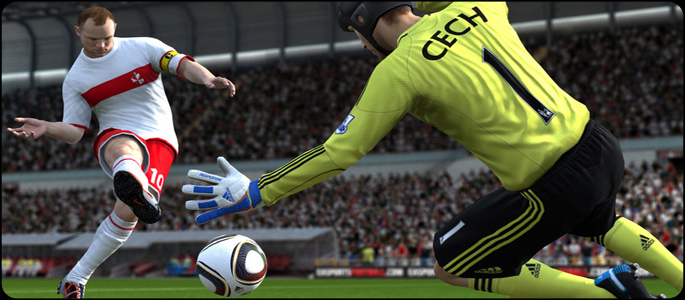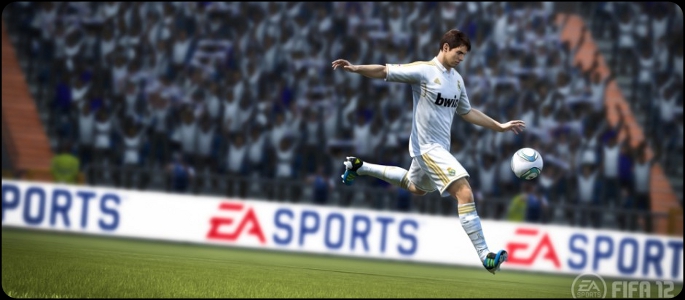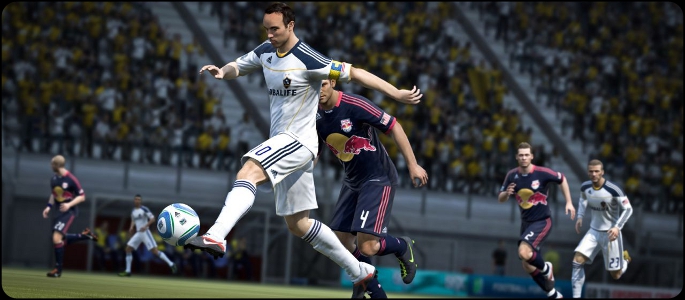It’s that time of year again – time for the leaves to change colors, temperatures to fall, days to become shorter, and, of course, time for some football soccer! FIFA has remained the top of the crown when it comes to video game incarnations of footy, with PES breathing right down its neck. This year, EA Sports has taken a bold move, and completely redone its defensive game. But do the major changes to its control style help or hurt the king of the pitch? Find out in our review!
When you boot up FIFA 12, you start in a practice mode where you can uncover a handful of options to mess around with. This includes setting up and testing set pieces, where you can set up routes for your teammates to run when your team has a throw-in or free kick. After messing around with that for a while, you eventually find yourself on the main menu that is quickly becoming ubiquitous in an EA Sports title. It’s similar in fashion to Madden and Tiger Woods. While some may not like this as it looks so similar to those other titles, I find it easier to use because things are sorted where you would expect them to be. Features introduced with this year’s installment such as those in Online Friendlies and Head to Head have their options highlighted with a “NEW!” badge.
EA has stated that the three major changes to this year’s game are called “Impact Engine,” “Precision Dribbling,” and “Tactical Defending.” The Impact Engine is a procedural animation engine that can create dynamic collisions between players. It seems to give more life to the action, and can also impact how intense an injury is received to a player. This includes those off the ball, so you have to be wary of your surroundings when you are running around as a single player. I was surprised when after a particularly nasty collision with another person, my player began limping around with a hurt leg. After standing still for a while, he slowly recovered. The game didn’t stop, but it came awfully close and reminded me to not play as aggressively.
Another new aspect to FIFA 12 is Precision Dribbling, which allows you to make smaller and more regular touches to the ball when an opponent is nearby or when you are closer to the goal and/or touchline. The AI automatically does this to a certain degree, as they are situation-aware and realize just where on the field they are. It’s a subtle new feature that makes players more responsive overall, and places more of the blame of a stolen ball or intercepted pass squarely on the gamer instead of the game itself.
Clearly the biggest change in FIFA 12 compared to its predecessors is the new method of playing defense, called Tactical Defending. Instead of rushing the attackers as in previous iterations, this portion of the game takes on a more “wait and see” method of defending. You stay just ahead of the ball carrier, and wait for the right moment to go in for a tackle. There’s a whole new control scheme to learn here, and it can definitely be tough for veterans of the series to get used to this method. You can use the legacy defensive control scheme if you like, but then again why not get used to the new system? It adds a lot of new depth to the game. Some people may say “if it ain’t broke, don’t fix it,” but this injects a whole new way to experience playing defense. Your best bet is to try the new method out in the demo currently available for download online.
EA is usually pretty reliable when it comes to a sports game’s music, and FIFA 12 has a large variety of music from around the world. Many of the songs chosen fit right into the soccer culture, and you may find yourself searching for some of these songs on iTunes or YouTube. While playing, crowds react to the action onscreen as well as could be expected, and it does sound realistic blasting out in surround sound. Custom soundtracks are also supported, though adding songs can be cumbersome if you do not have playlists pre-defined. Since you cannot create custom playlists in-game, be sure to have those set up ahead of time.
One of the few disappointments in FIFA 12 is surprisingly the presentation. While other sports games have really amped up the visuals lately, FIFA 12 doesn’t look much different when compared to last year’s game. The game may play in 1080p, but it is most assuredly being upscaled. Players feel pretty static – their hair seems painted on, facial animations are difficult to discern, and after a goal they just start running like crazy to the goal scorer, often times running in place against other players who are in their direct path. Also, while the idea of two teams of commentators sounds good on paper, in reality it makes the game feel a bit less like a real broadcast than before. The introduction by the commentators of the two competing teams ends up sounding incredibly generic, with statements such as “this looks like an interesting match-up” often being the only said thing before viewing the lineups.
One other troublesome spot in FIFA 12 is the difficulty setting. At Amateur, the game is far too easy, even when tested against people who don’t play soccer games. In my first game at that setting, for example, I ended up decimating the opposing team 8-0. I was hardly trying, and goals were constantly being handed to me on a silver platter. If you’re playing the “Be A Pro” mode, where you control a single pro on the field, the game is practically on auto-pilot at this setting. Turn the difficulty up to Semi-Pro, and the games become much more realistic. Turning the difficulty level just one more level beyond that almost makes the game unfair as the AI becomes unrealistically accurate and hard to predict. But considering that there are five difficulty levels, playing at the highest mode dubbed “Legendary” is no doubt going to be the cause of many broken controllers. EA does give you sliders galore, however, so if you find the Amateur setting is too easy you can dial up how accurate or aggressive the CPU is. This goes a long way to making games more believable than what they turn out to be with sliders set to default levels.
Online modes are here in droves, but if you bought the game secondhand then prepare to pony up the cash for an EA Online Pass. Introduced this year is the EA Sports Football Club. You pick a team that you will represent, and almost every action you perform in FIFA 12 earns you experience points, both online and off. This can in turn level you up, which adds to your team’s overall ranking. That ranking is determined based on the average XP contributed by team members over the course of a week, which ensures teams with less members have a shot at their club being fairly represented. At the end of the week winning teams are announced, and a new tournament begins. It adds a nice competitive incentive to keep gamers constantly trying out new areas of the game that they may not have otherwise given a look at. When playing online, we didn’t notice any issues regarding lag or an inconsistent connection. You pick the team that you want to play ahead of time, and this results in a much more fair match-up. I thank EA for their matchmaking system, and hope to see it implemented in their other titles. Of course, your mileage will vary here.
So for the most part, FIFA 12 is a great update to the longstanding franchise. With some new online modes, tighter dribbling control, and a new procedural animation engine, the game can feel more like real-life at times. While the new defensive control scheme is certainly a bold move, it is a double-edged sword that may alienate veteran players at first. It does grow on you over time, but prepare to set aside some time to learn the new system. Presentation could definitely use a tune-up, and the default difficulty settings leave a lot to be desired, but at least that can be fixed with the game’s sliders. FIFA 12 is well worth a soccer fan’s time.
PlayStation LifeStyle’s Final Score
+ New defensive system is ultimately rewarding. – Presentation could use improvements, difficulty levels ramp up too quickly. |
 |






